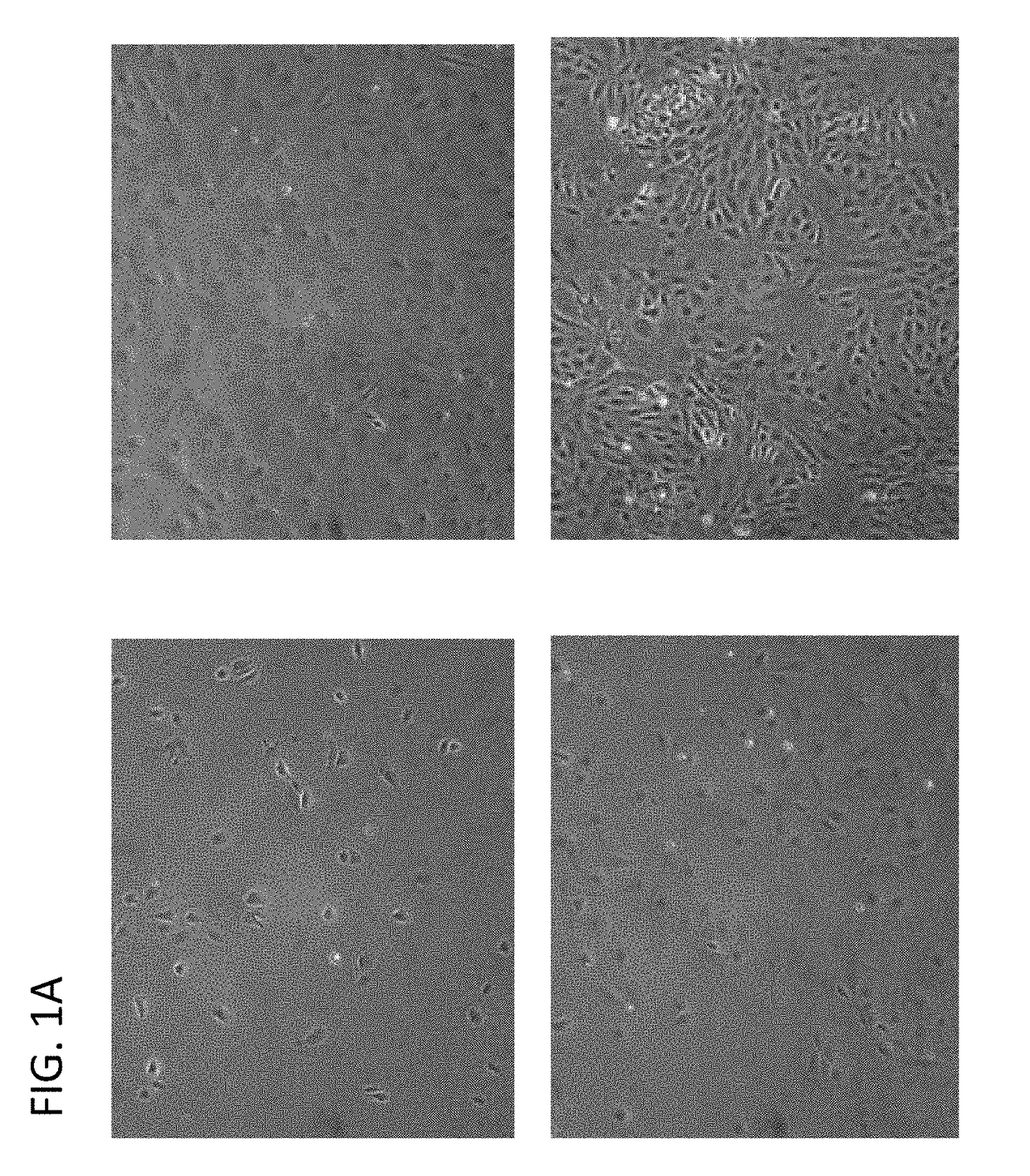Induction of hepatocytes by stem cell differentiation with RNA
a stem cell and stem cell technology, applied in the field of induction, can solve the problems of difficult effective dose control, unintended target non-specific effects of small molecules, and difficulty in finding reliable supply of donor liver, and achieve the effect of high efficiency of specific differentiation
- Summary
- Abstract
- Description
- Claims
- Application Information
AI Technical Summary
Benefits of technology
Problems solved by technology
Method used
Image
Examples
example 1
g Endoderm Cells from iPSCs
[0120]iPSCs were plated into standard size 6-well cell culture plates (about 9.5 cm2 growth area / well) or standard size 12-well cell culture plates (about 3.8 cm2 growth area / well) to begin differentiation. Other sized culture vessels are optionally applicable as well and sometimes may be more preferred over 6-well or 12-well plates because of higher efficiency of the use of reagents and time.
[0121]In a 6-well plate (standard commercially available), cells of a population size from 1×105 to 4×105 per well have been successfully used. iPSCs were considered ready for differentiation when there were enough typical iPSCs colonies with sharp well-defined edges, where the cells are compact, and colonies were not overgrown. The quality of iPSC's of the present invention produced using these criteria proved to be critical for differentiation when the iPSC lines of the present invention were compared with iPSC lines that were produced by others using other methods....
example 2
g Hepatic Progenitor Cells from Endoderm Cells
[0128]Endoderm cells are plated on commercial cell culture vessels. 6-well plates were used in experiments shown in FIG. 2, but other well sizes are applicable. Plates were pre-coated with Matrigel (BD Biosciences), 1×105-1×106 cells were then plated in DMEM / F12 or MCDB131 supplemented with 8 mM D-glucose. Sometimes adding 1% DMSO at this stage was observed to helpful for increasing the efficiency of generating hepatic progenitor cells.
[0129]In one experiment, cells were then transfected with Hex and / or Tbx3 mRNA. Additionally, the cells were transfected or co-transfected, for stronger effects, with mRNA for GATA4, GATA6 mRNA at a dose of 50 ng per well with Stemgent Transfection Reagent (Stemgent) in culture medium, and repeated for 2, 3, or more times, at doses at low as 10 ng and as high as 200 ng per well, using Stemgent Transfection Reagent or other commercially available transfection reagents. In some aspects the Stemgent concentra...
example 3
g Hepatocytes from Hepatic Progenitor Cells
[0130]Hepatic progenitor cells were cultured in 6-well or other plates pre-coated with Matrigel (BD Biosciences) or Collagen I (Sigma) in DMEM / F12, MEMa, or DMEM B27. Other similar attachment cell culture medium is also suitable for use.
[0131]Hepatic progenitor cells were further transfected with HNF1a, HNF4a, HNF6, CEB / Pa, or CEB / Pb mRNA at a dose of 10-200 ng per well with Stemgent Transfection Reagent (Stemgent) in culture medium supplemented with 200 ng / mL B18R. The dose of Stemgent may also be about 10, 20, 30, 40, 50, 60, 70, 80, 90, 100, 110, 120, 130, 140, 150, 160, 170, 180, 190, or 200 ng per well, or any amount between any two of the recited amounts. This amount may also be adjusted for other well volumes. Most commercially available transfection reagents are also applicable. Hepatocytes were obtained at this stage by passing the progenitor cells to lower density in hepatocyte medium (FIG. 3).
PUM
 Login to View More
Login to View More Abstract
Description
Claims
Application Information
 Login to View More
Login to View More - R&D
- Intellectual Property
- Life Sciences
- Materials
- Tech Scout
- Unparalleled Data Quality
- Higher Quality Content
- 60% Fewer Hallucinations
Browse by: Latest US Patents, China's latest patents, Technical Efficacy Thesaurus, Application Domain, Technology Topic, Popular Technical Reports.
© 2025 PatSnap. All rights reserved.Legal|Privacy policy|Modern Slavery Act Transparency Statement|Sitemap|About US| Contact US: help@patsnap.com



